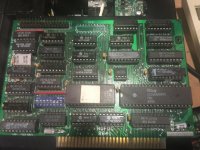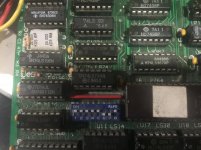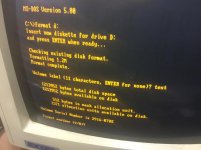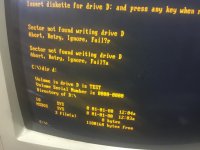SpidersWeb
Veteran Member
I'm doing an XT build with a 286 processor (kind of like a Tandy TL/2 setup).
It came with a HD FDC with a Boot ROM which is able to auto detect 80 or 40 track drives on startup. However it's acting completely bizarre.
MS DOS 3.3 knows Drive A is 80 track, on a few random occasions instead of Track 0 failure it's actually started formatting and made the drive a full 1.2MB. However after it finished, the disk was unusable, throwing sector not found errors.
MS DOS 5 sees it as a 360KB drive. Using DRIVER.SYS to create a 1.2MB logical drive allows MS DOS 5 to try, but it has the same results as MS DOS 3.3 did - either Track 0 bad, or formats and then gives sector not found issues at the end.
Using the same drive with a generic controller (capable of HD), the machine behaves the same way - and will not boot AT ALL from a HD floppy nor read it. But if I use ImgDisk to go straight to hardware - it can read and write the floppy no problemo!
(NB: having the FDC ROM loaded causes ImgDisk to lock the machine - hence the card swap).
It will also refuse to read/write 360KB disks in the 1.2 drive.
The second drive, 360KB, works 100% correctly.
Other random moments:
- with FDC ROM installed, system read and booted from a freshly written MS DOS 5.0 boot disk, ran programs, no problem - but you press CTRL+ALT+DEL and now suddenly the system can not work with the floppy whatsoever despite me not touching the computer at all. It wont boot it, it wont read it.
- on a few occasions I've been able to "DIR A:" with pre-created disks and see the file details, but trying to run a program would lead to errors
Stuff I've done:
- switching, cleaning, testing 1.2 floppy drives
- testing the card in a DTK XT - would not boot 1.2 floppy
- after failing to read disks, I'd take them to yet another system and read them perfectly (no bad sectors, these are new disks)
- reseated all chips on the FDC ROM
- switched A and B around
- tried one single drive or multiple
- used another (non-ROM) controller + ImgDisk to confirm the drive and disk are working correctly
- tried adjusting the switches on the card - but the 8 switches actually appear to just be Enable and the ROM address.
- switched cables
- changed power supply
- unplugged hard drive
- remove hard drive controller
- remove all other cards except graphics
So my questions are:
- what is required for a HD floppy to behave correctly on an XT?
- how can I test / see to know what DOS is being told? Maybe the controller thinks it's 720KB??
- any other tests or possible explanations?
Disk Drives being used are all Panasonic 1.2's - I can't remember what drive originally came in the machine, but someone has scratched "Drive A 1.2MB" in to the case - so it used to work once.
Hopefully there is an easy answer, because I was getting a little frustrated last night.
It came with a HD FDC with a Boot ROM which is able to auto detect 80 or 40 track drives on startup. However it's acting completely bizarre.
MS DOS 3.3 knows Drive A is 80 track, on a few random occasions instead of Track 0 failure it's actually started formatting and made the drive a full 1.2MB. However after it finished, the disk was unusable, throwing sector not found errors.
MS DOS 5 sees it as a 360KB drive. Using DRIVER.SYS to create a 1.2MB logical drive allows MS DOS 5 to try, but it has the same results as MS DOS 3.3 did - either Track 0 bad, or formats and then gives sector not found issues at the end.
Using the same drive with a generic controller (capable of HD), the machine behaves the same way - and will not boot AT ALL from a HD floppy nor read it. But if I use ImgDisk to go straight to hardware - it can read and write the floppy no problemo!
(NB: having the FDC ROM loaded causes ImgDisk to lock the machine - hence the card swap).
It will also refuse to read/write 360KB disks in the 1.2 drive.
The second drive, 360KB, works 100% correctly.
Other random moments:
- with FDC ROM installed, system read and booted from a freshly written MS DOS 5.0 boot disk, ran programs, no problem - but you press CTRL+ALT+DEL and now suddenly the system can not work with the floppy whatsoever despite me not touching the computer at all. It wont boot it, it wont read it.
- on a few occasions I've been able to "DIR A:" with pre-created disks and see the file details, but trying to run a program would lead to errors
Stuff I've done:
- switching, cleaning, testing 1.2 floppy drives
- testing the card in a DTK XT - would not boot 1.2 floppy
- after failing to read disks, I'd take them to yet another system and read them perfectly (no bad sectors, these are new disks)
- reseated all chips on the FDC ROM
- switched A and B around
- tried one single drive or multiple
- used another (non-ROM) controller + ImgDisk to confirm the drive and disk are working correctly
- tried adjusting the switches on the card - but the 8 switches actually appear to just be Enable and the ROM address.
- switched cables
- changed power supply
- unplugged hard drive
- remove hard drive controller
- remove all other cards except graphics
So my questions are:
- what is required for a HD floppy to behave correctly on an XT?
- how can I test / see to know what DOS is being told? Maybe the controller thinks it's 720KB??
- any other tests or possible explanations?
Disk Drives being used are all Panasonic 1.2's - I can't remember what drive originally came in the machine, but someone has scratched "Drive A 1.2MB" in to the case - so it used to work once.
Hopefully there is an easy answer, because I was getting a little frustrated last night.





